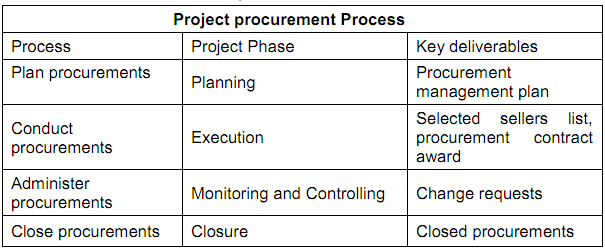Overview of Procurement Management
Let us start our discussion with an overview of project procurement management. Procurement management is an important knowledge area in project management and it is a formal process by which many organisations acquire their goods and services from outside body. Hence, project procurement management involves getting work done by people outside the project organisation. It includes the management of purchasing or acquiring of product, services, or projects.
According to PMBoK1 "project procurement management includes the processes necessary to purchase or acquire products, services, or results needed from outside the project team". The organisation can be either buyer or seller of the products, services, or results of a project".
Project procurement is mostly managed by project managers and specialists. Project procurement process includes the following processes (as per PMBoK):
1. Plan procurement.
2. Conduct procurement.
3. Administer procurement.
4. Close procurement.
The table shows the key deliverables in each of these processes.
Table : Project Procurement Processes 
These processes interact with each other and involve efforts from a group or person involved in the project. The processes also interact with processes in the other knowledge areas. We must note that all these processes occur at least once in the life cycle of every project and may occur in one or more phases of the project. Although the processes look as different components but they overlap and interact with each other in real time. The project procurement management involves legal documents signed between the buyer and the seller. This includes terms and conditions incorporated by the buyer depending on what the seller would perform or provide.
The project management team is responsible to make sure that all procurements meet the project needs while adhering to the organisational procurement policies. The project management team may seek support from experts in contracting, purchasing law, and technical disciplines to ensure that all the project needs are met, while the organisational procurement policies are adhered. The activities involved in procurement processes form the life cycle of contracting. By continuously managing the contract life cycle the project management team can avoid some unidentified risks.
If the project is large, then the buyer-seller relationship exists at different levels and so the co-ordination must be maintained at each and every level correctly. Depending on the application area we can call the seller as contractor, subcontractor, vendor, service provider, or supplier. Depending on the buyer's position in the procurement cycle, we can name the buyer as client, customer, prime contractor, service requestor, governmental agency, or purchaser.